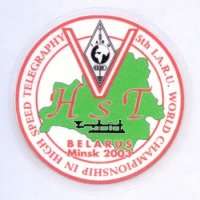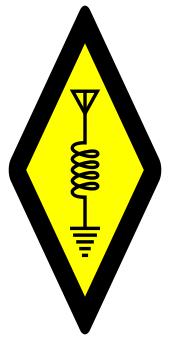High-speed telegraphy
In amateur radio, high-speed telegraphy (HST) is a form of radiosport that challenges amateur radio operators to accurately receive and copy, and in some competitions to send, Morse code transmissions sent at very high speeds. This event is most popular in Eastern Europe. The International Amateur Radio Union (IARU) sponsors most of the international competitions.
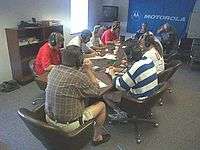
History
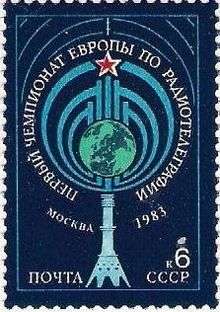
The first international high-speed telegraphy competition was the HST European Championship held in Moscow, Russia, in 1983. Two more HST European Championships were held; one in 1989 in Hannover, Germany, and another in 1991 in Neerpelt, Belgium. The first HST World Championship was held in Siófok, Hungary, in 1995. A world championship has been held in every odd-numbered year since then.
Most international, national, and local HST competitions are held in the countries of the former Eastern Bloc. Every world championship has been held in Europe. While many competitors are licensed amateur radio operators, there is no requirement that competitors have an amateur radio license, and many pursue the sport without one.
Competition events
There are three main competitive events at HST meets. One standard event is the copying or sending of five-character groups of text. Two of the events are based on simulations of amateur radio activity and are referred to as the Radioamateur Practicing Tests (RPT). The RPT includes the copying of amateur radio call signs and a "pileup" competitions, where competitors must distinguish between call signs sent during several simultaneous transmissions. Not all competitors are required to enter every competition, and some competitors specialize in just one competitive event.[1]
In the five character groups event, random letters and numbers are sent in Morse code, five characters at a time, at a high speed. Separate competitions are held for the reception of just the twenty-six letters of the Latin alphabet, just the ten Arabic numerals, or a mixed content of letters, numbers, and some punctuation symbols. Competitors may choose to record the text by hand on paper or by typing on a computer keyboard. The competition starts with one minute of transmission sent at an initial speed defined for the entry category (usually 50 letters per minute for juniors and 80 letters per minute for the other age categories). After each test, the copy of the competitors is judged for errors. Subsequent tests are each conducted at an increased speed until no competitor remains who can copy the text without excessive error.[1]
In addition to reception tests, some competitions feature transmission tests where competitors must try to send five character groups in Morse code as fast as possible. Competitors send a printed message of five character groups at a specific speed, which is judged for its accuracy by a panel of referees. Like the receiving tests, there are separate competitions for sending five character groups of just the twenty-six letter of the Latin alphabet, just the ten Arabic numerals, or a mixed content of letters, numbers, and some punctuation symbols. Most transmission tests restrict the type of equipment that may be used to send the Morse code message.[1]
The Amateur Radio Call Sign Receiving Test use a software program called RufzXP that generates a score for each competitor. Rufz is the abbreviation of the German word "Rufzeichen-Hören" which means "Listening of Call Signs". In the RufzXP program, competitors listen to an amateur radio call sign sent in Morse code and must enter that callsign with the computer keyboard. If the competitor types in the call sign correctly, their score improves and the speed at which the program sends subsequent call signs increases. If the competitor types in the call sign incorrectly, the score is penalized and the speed decreases. Only one call sign is sent at a time and the event continues for a fixed number of call signs (usually 50). Competitors can choose the initial speed at which the program sends the Morse code, and the winner is the competitor with the highest generated score.[1]
The Pileup Trainer Test simulates a "pileup" situation in on-air amateur radio operating where numerous stations are attempting to establish two-way contact with one particular station at the same time. This competition uses a software program called MorseRunner. In the MorseRunner software, more than one amateur radio call sign is sent at a time. Each call sign is sent in Morse code generated at different audio frequencies and speeds, timed to overlap each other. Competitors must record as many of the call signs as they can during a fixed period of time. They may choose to do this either by recording the call signs by hand on paper, or by typing them in with a computer keyboard. The winner is the competitor with the most correctly recorded call signs.[1]
The rules of international and European championships are defined in the document IARU Region 1 Rules for High Speed Telegraphy Championships.
Entry categories
HST competitions generally separate the competitors into different categories based on age and gender. The following are the entry categories specified in the IARU rules used for European and World Championships:
- Women aged 16 years and younger (A).
- Men aged 16 years and younger (B).
- Women aged 17 to 21 years old (C).
- Men aged 17 to 21 years old (D).
- Women, regardless of their age (E).
- Men, regardless of their age (F).
- Women aged 40 years and older (G).
- Men aged 40 to 49 years old (H).
- Men aged 50 years and older (I).
Note that there is an additional male category, which is justified by the high number of participants in the corresponding age group. A maximum of 18 competitors from those 9 categories can take part as a national team.
Past IARU Championships
IARU World Championships take place in odd year, starting 1995. Since 2004, an IARU Region 1 Championship takes place each even year.
- 2016 Herceg-Novi, Montenegro [2]
- 2014 Bar, Montenegro [3]
- 2012 Beatenberg, Switzerland [4]
- 2009 Obzor, Bulgaria [5]
- 2008 Pordenone, Italy [6]
- 2007 Belgrade, Republic of Serbia[7]
- 2006 Primorsko, Bulgaria [8]
- 2005 Ohrid, Republic of Macedonia[9]
- 2004 Niš, Republic of Serbia [10]
- 2003 Minsk, Belarus[11]
- 2001 Constanţa, Romania[12]
- 1999 Pordenone, Italy[13]
- 1997 Sofia, Bulgaria
- 1995 Siófok, Hungary
Regional Championships
- 2013 1st Balkan High Speed Telegraphy Championship, 31 May - 2 June, 2013. Lovech, Bulgaria
- 2014 2nd Balkan High Speed Telegraphy Championship, 13–15 June 2014. Piatra Neamţ, România
- 2015 3rd Balkan High Speed Telegraphy Championship, 15-17 May, 2015. Svilajnac, Serbia
13th IARU World HST Championship
13th IARU World HST Championship was held in Herceg-Novi, Montenegro from 21 till 25 September 2016. Competing in 9 categories with 8 types of tests, there was more than 120 competitors from 21 countries around the world.
| Rank | Country | Score |
|---|---|---|
| 1 | 6397.9 | |
| 2 | 5515.5 | |
| 3 | 4777.6 | |
| 4 | 3079.9 | |
| 5 | 2340.7 | |
| 6 | 1708.4 | |
| 7 | 1564.2 | |
| 8 | 915.6 | |
| 9 | 806.0 | |
| 10 | 669.7 |
| Callsign | Name | M/F | Team | Test | Record | Old record |
|---|---|---|---|---|---|---|
| EW8NK | Hanna Shavialenka | F | Receiving Figures | 310 | 310 | |
| EW8NK | Hanna Shavialenka | F | Receiving Mixed | 240 | 240 | |
| RA4FVL | Anna Sadukova | F | Receiving Mixed | 240 | 240 |
IARU world records
The IARU Region 1 HST working group maintains a list of HST world records,[15] set at official IARU HST competitions. Top speeds vary strongly between the different events of the competition and categories. While reception and transmission of letter groups are limited to approximately 300 characters per minute, mainly due to physiologic difficulties in sending or writing at high speeds respectively, the maximum speeds in the RufzXP competition are more than twice as fast.
Note that the system to measure the telegraphy speed at IARU HST events has changed. Before 2004, the PARIS standard was used, which has since been changed to real characters. Old records have been recalculated accordingly.
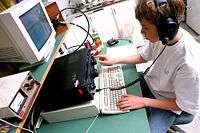
Successful teams
The sum of all team scores of the top ten nations from all HST events since 1999 are tabulated below. Note that some teams did not take part in all competitions. Last updated in September 2009 after the World Championships in Obzor, Bulgaria.
| Rank | Score | Country | Entries |
|---|---|---|---|
| 1 | 48286.2 | 9 | |
| 2 | 45237.4 | 9 | |
| 3 | 34874.8 | 9 | |
| 4 | 26858.5 | 9 | |
| 5 | 13140.5 | 9 | |
| 6 | 12902.3 | 9 | |
| 7 | 10365.1 | 7 | |
| 8 | 9631.1 | 9 | |
| 9 | 8961.4 | 9 | |
| 10 | 7449.7 | 6 |
See also
Notes
- High Speed Telegraphy World Championships. ARRL. Retrieved 11 August 2014.
- 13th World HST Championship 21.-25. September 2016
- 8th IARU Region 1 HST Championship 12.-16. September 2014
- "http://www.hst2012.ch/". Archived from the original on 2012-03-02. Retrieved 2012-02-23. External link in
|title=(help) - "http://www.hst2009.eu/". Archived from the original on 2009-09-27. Retrieved 2009-09-17. External link in
|title=(help) - http://www.hst2008.org/
- 7th WORLD HST CHAMPIONSHIP
- Source link dead as of 13 August 2007: http://bfra.mtt.bg Archived 2006-10-04 at the Wayback Machine
- Source link dead as of 13 August 2007: http://www.hst2005.com.mk/Fr/home.htm Archived 2005-02-14 at the Wayback Machine
- DARC Committee DX and HF-Contesting
- DARC Committee DX and HF-Contesting
- DARC Committee DX and HF-Contesting
- DARC Committee DX and HF-Contesting
- 13th World HST Championship Results
- http://www.iaru-r1.org/index.php?option=com_content&view=article&id=284:official-hst-world-records&catid=46:hst&Itemid=98
External links
- IARU Region 1 HST Working Group
- RufzXP Software by DL4MM and IV3XYM
- NØHR.com: RufzXP and stats Using statistics to track CW speed improvement in RufzXP
- MorseRunner Software by VE3NEA
- PED software by JE3MAS (PED was used in official competitions until 2005, now replaced by MorseRunner)
- Hollemans, Wilko PA3BWK (1999). "High Speed Telegraphy: European /World Championships". Retrieved Dec. 6, 2005.
- High Speed telegraphy and speed-writing German Telegraphy-page of Ludwig Szopinski, DK5KE
References
- Battey, E.L. W1UE. "Flash! W9ERU Wins Code Speed Contest". QST. Oct., 1936. p. 39.
- IARU Region I High Speed Telegraphy Working Group (2004). "Rules for High Speed Telegraphy Championships". Retrieved Dec. 6, 2005.
- Kolpe, Mathias DL4MM (2004). "6th HST World Championships / Ohrid - Macedonia". Retrieved Dec. 6, 2005.
- Kutner, Barry W2UP. "High Speed Telegraphy Competition in Macedonia". QST. 2005.
- Lindquist, Rick N1RL. "World Championship in High Speed Telegraphy Set." QST. Apr. 1997, p. 75.
- Lindquist, Rick N1RL, ed. "Guinness World Records recognizes high-speed telegraphy achievement". ARRL Letter. Vol. 23, No. 48. Dec. 10, 2004.
- Novak, Adolf OK1AO (1997). "HST". Retrieved Dec. 6, 2005.
